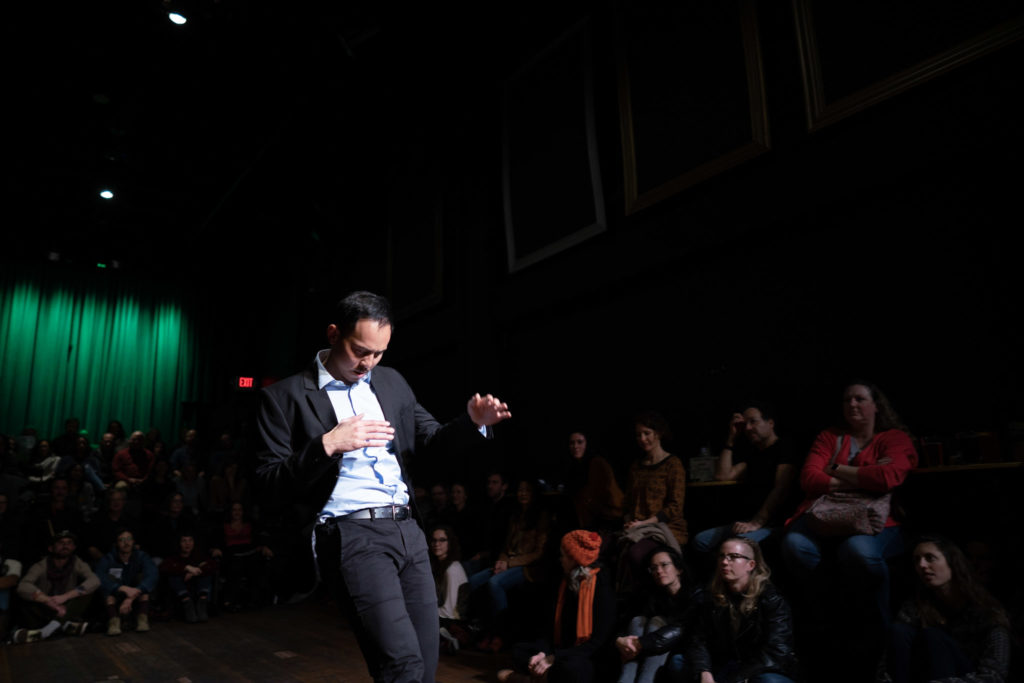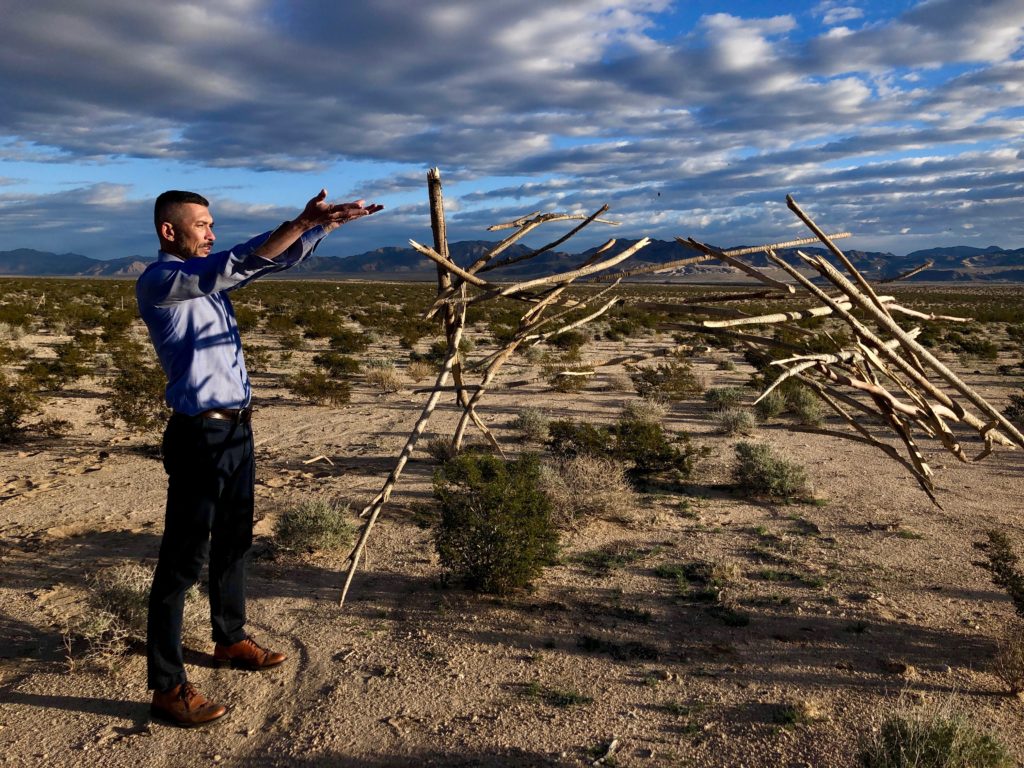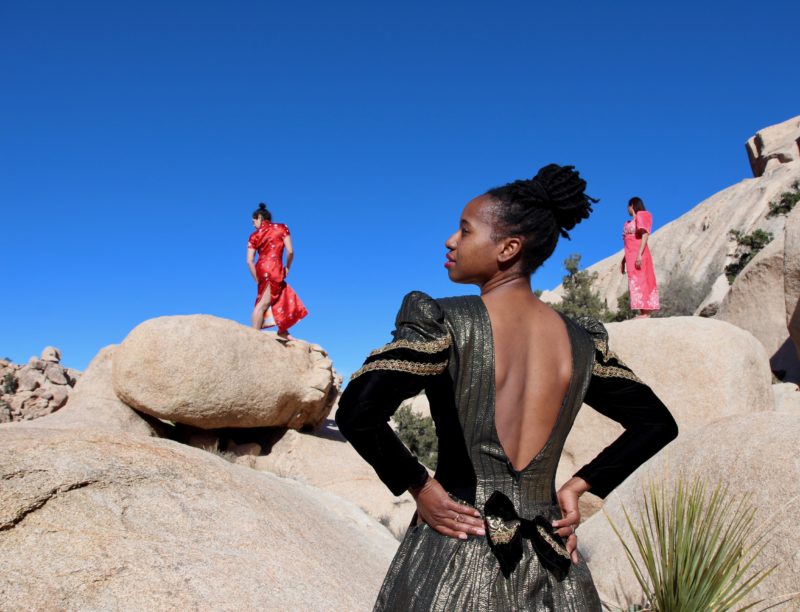My hairdresser is obsessed with tracking Mountain Lion sightings in the Santa Cruz mountains. She follows locals on instagram who live along the lion’s territorial maps and also the online Santa Cruz Puma Project tracking system. I understand the appeal. There is something about these majestic, elusive creatures that pulls our imagination. Perhaps it is the tingle of possibility that comes from thinking about a being that sets its own trajectories within an organic relationship to ecological principles that operates outside of our constrained territorial grids and power lines. It is incredible that something so wild, so powerful, so mysterious lives so close. A sighting feels both magical and sacred. That is how I feel about Fog Beast.
The first Fog Beast duet I saw was in a bar in May 2011. Your Favorite Game was a striking combination of a tavern song and a christening ceremony. Or maybe it was a wedding? Co-directors Melecio Estrella and Andrew Ward emerged from the crowd with beer mugs raised, their bodies vibrating with a focused magnetic resonance. Is it a ritual? A story? A dance? Are they summoning the Evangelical Rapture that was predicted to happen that month?
Fog Beast evades definition and so as I track them through the years it is an alchemical quality along, with a refreshing irreverence towards expected narratives, that leads me closer. Much like my hairdresser, my obsession has led me to connect with those others that live in process with, and near, the Fog Beast. This connection has helped gain insights and glimpses into the making of their new work, The Big Reveal, a performance-as conference-as ritual, to be held at the Asian Art Museum in mid July. Fog Beast is unpacking and spreading out the ragged vestiges of our colonial inheritances and the contemporary corporate narratives that shape our patterns of belonging or not belonging. As they work together, they invite each performer to bring themselves and their histories into the creative process.
Melecio Estrella shares “I’m really interested these days in lineage. Where we find ourselves is a result of strands of lineage on so many levels braided together – biological or familial lineage, our dance and performance lineage, our social governmental lineages, so much of the way we live and think is inherited from who and what came before. As collaborators we show up in the room with all these lineages… and in this way we are so rich with material embedded in our dancing bodies and emotional topographies. What we do with our time together, what we choose to pass on through our work of embodied storytelling, is one way our lineages may continue through us to future generations. We are not looking to hire dancers. We are looking to gather a sensitive, funny and skillful group of kind humans to play with these entwined fibers of lineage.”
Hearing from some of the performers in The Big Reveal is particularly poignant given that Fog Beast is building the piece collaboratively and drawing from the performer’s personal experiences and identities. Below are excerpts of conversations with Patricia West, Danny Nguyen, and Wailana Simcock. Also performing in The Big Reveal will be Melissa Lewis, Janine Cayla Trinidad and Katie Faulkner.
* * * * * *
Fog Beast performer Patricia West (pictured above) holds a central role in their productions. The depth and nuance of her performance practice reflects the Fog Beast values in transcending traditional delineations. In He is One of Us (2017), Patricia’s personae as the corporate CEO commanded our attention immediately upon her entry. Her amplified armor was shed and dissolved throughout the piece until we rediscover her in a transformed state engaged in a pivotal, powerfully sacred solo that energetically ricocheted through the room. We are transfixed and maybe even a bit healed as we experience the personae slip away and Patricia emerged in a fully embodied and revealed state. As she and Fog Beast were making that solo, the emphasis was on her ancestors. Through her dancing (and later in song) she was both welcoming them and honoring them.
Damara: How do you experience yourself as part of Fog Beast? How would you describe your experience as a collaborator so far?
Patricia: If you are in the room, you are part of the Beast. I feel that as a collaborator of Fog Beast, they embrace the individual as part of the whole. I feel that my voice is heard and responded to. My curiosities and intrigues oftentimes become those of the group. And we all share the value of process. And Fog Beast doesn’t avoid the uncomfortable, they don’t fear saying or doing something that speaks a truth.
Damara: Do you have any thoughts/reflections about the content of the new piece so far that you would be willing to share? What are you curious about?
Patricia: Recently, I’ve thought about the “conference culture” in our society today. Conferences fulfill various needs. Sometimes, it’s a simple check mark needed for work or a promotion. Other times, it is an opportunity to stop, take a breath, reassess and reflect. Our Fog Beast piece is a conference “for the people.” I’m curious about what “people” need and want in a conference? As performers, what can we call on for the audience to engage in, both in the performance context but also after they leave that space. What is our collective responsibility?
Damara: You have performed all over with Fog Beast. And context is always important to their work and its content. Do you have any thoughts about performing in the context of the Asian Art Museum?
Patricia: I do feel that us performing in the Asian Art Museum (and the fact that one of the Fog Beast founders is of Asian descent as are several of the other performers) places an emphasis on race and those that identify with being Asian-American. I’m curious how this will play out in the piece. I know and hope we will be mindful of all the possible interpretations this may bring forth. Also, by performing in a museum, I feel we are committing to making our piece pertinent to history, culture and community.

I have long admired Fog Beast artist Danny Nguyen and his capacity to entice the audience into laughter with a blend of dry humor and absurd physical comedy. In our chat, Danny offered resonant reflections on how humor has enriched his experience being a part of the Beast and how he is bringing his personal explorations about identity into the process of building The Big Reveal.
Damara: What motivates you to contribute your artistry in the creative process with Fog Beast? What draws you in? What keeps you coming back?
Danny: I think the humor that comes out of it. I’m really not into a lot of dance shows because it gets so serious and I just can’t get into it. So we do dance moves like everybody else because you know it’s dance but within all of it comes out funny stuff for me and so I like that.
Damara: At the December Joshua Tree retreat with Fog Beast [to] I noticed that people shared parts of themselves that they might not have in a rehearsal studio. Like, I’m not sure people knew you were a bad-ass musician and could play the saxophone and also fix everyone’s electronics. And I learned you like to cook and ride a bike super fast, and that you grew up in Palm Springs which is an hour away from Joshua Tree. There are so many dimensions to who you are, which might never be revealed in the context of that blank rehearsal space. Do you feel like that’s a benefit to the work that Melecio and Andrew are trying to do with The Big Reveal?
Danny: Yes totally because dancing and doing this kind of work where we are trying to get into deeper subjects, it’s easy to share some surface layer stuff and get to know each other that way so when we come in here (rehearsal) we can go to the deep place but it feels ok because we’ve already established a surface level relationship. Because we are all so complicated and three dimensional in who we are – just seeing the dance side of the person is so flat.
Damara: How are they drawing from your personal experiences as they construct The Big Reveal?
Danny: I think a big part of me went into the section we just built. I work four days a week at Apple and have been doing that for two years… A section that I just built with Fog Beast, and performed at the last 8X8X8, was about a reveal of a new product and I thought “oh this is exactly like what Apple does every year.”
Damara: You recently performed an excerpt of The Big Reveal in a bar in Oakland. How do feel about performing the work in a museum and specifically the Asian Art Museum?
Danny: Yeah. I mean. I don’t really know. So my first thought is that I guess I should have feelings about it and my second thought which is related to my first thought is I don’t fully identify as an Asian person. Or I don’t feel it as much as people viewing my body feel it. Right, they see me and they are like “Asian man ok cool.” I grew up in the suburbs and have always participated in things that have had more privilege and so more white people and … my circles happened to be mostly white and never really had Asian friends or even Vietnamese friends really so not a huge sense of connection to that side of me which is fully real because both my parents are Vietnamese. In me looking out as I traverse the world I don’t see myself as an Asian person [until] I’ve gotten feedback that reminds me that I am.
The complexity of identity, who we are in the world and how we are with one another is the melodic underbelly of the Beast. In opening rehearsal circles for The Big Reveal Melecio requests that the artists bring their full selves into the room with them. There is an acknowledgment that each of us has complex lives, identities and personal trajectories.

Fog Beast artist Wailana Simcock’s presence in rehearsals and performances draws us deep past the surface and we are so willing to follow him wherever he wants to take us. In our conversation we spoke about the context of Fog Beast as a place where the whole person is invited.
Damara: The other day we were talking about how it is not just your ‘dancer body’ being invited into the Fog Beast work, it’s you in a more dimensional capacity. Like your lineage, your immigration story, your family’s history, your identity and your languages. You were talking about not having to edit parts of yourself out as you work with Fog Beast. What has that been like for you?
Wailana: Coming from Hawaii we always talk about our ancestors. That’s always first. And God and spirituality. That’s revered first and then all the other details come into play depending on the project. In my schooling, in my training, I had to learn to chant in Hawaiian. I had to share where my mother is from, where my father is from, where I was born, where I was raised, as an introduction to who I am so that all of me is invited and so everyone could understand the bigger picture of me.
Coming back to the continent after being away for 17 years, coming back as a dancer, in many ways I am the same person but I have also changed. In many ways I have gotten deeper into who I am and at the same time I am still sort of lost and I realized that there are many other people like myself who feel more lost than they do connected to places of birth and ancestry because you know colonization really wreaked a lot of havoc and confusion with identity.
I feel like Melecio is trying to invite me to be my whole self in Fog Beast and I think that in his search for his identity and for who he is, we are brothers in that way. Perhaps we are both sort of lost in this world trying to find our voices and trying to find who we are and the more I feel like I do that for myself I realize that we are all doing this. That we are all looking for our ancestors and roots. Our indigeneity.
I wonder sometimes maybe for white people – they don’t question or ask who their ancestors are and what they’re indigenous to and what their indigenous languages are and they are maybe ok with just saying that they are white. And I’m like “ok I know you are white but like what kind of white? Where did your ancestors come from? What did they speak? What did they eat? What mountains did they look up to and what rivers and oceans were they are part of?
In Fog Beast I am invited to speak the languages that I speak and share them. I feel a refreshing support and I don’t have to edit myself so much.
* * * * * *
So come to The Big Reveal. You are invited. My hairdresser will be there. She can show you photos of her Mountain Lions and together you and she can be amazed. Out beyond the Bay Area traffic and escalating rents, a beast is traversing the hillsides, its movements revealing the mysterious ecology of connection of which we are all a part.
So come. Be daring. Show yourself. Bare your teeth, heart, your desires. Step into the conference, that is a performance, that is a ritual. Bring your ancestors. You belong there.
This article appeared in the June 2019 issue of In Dance.


